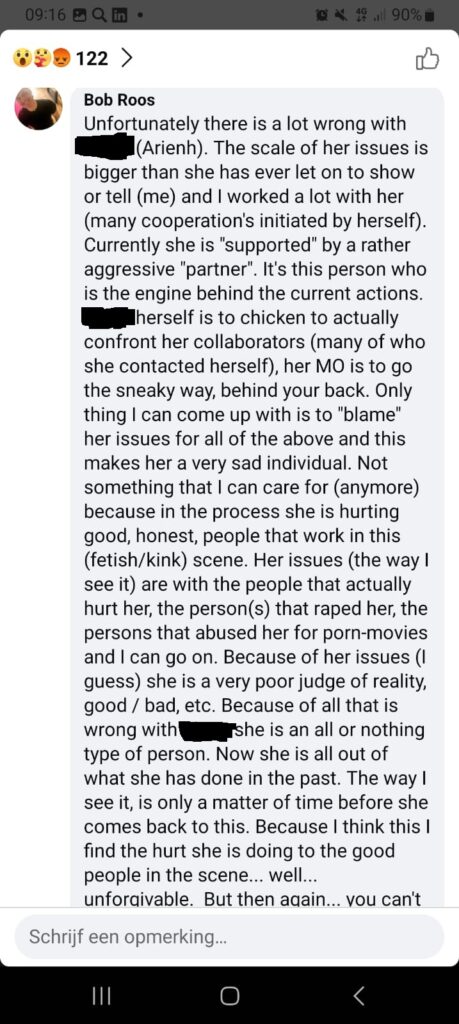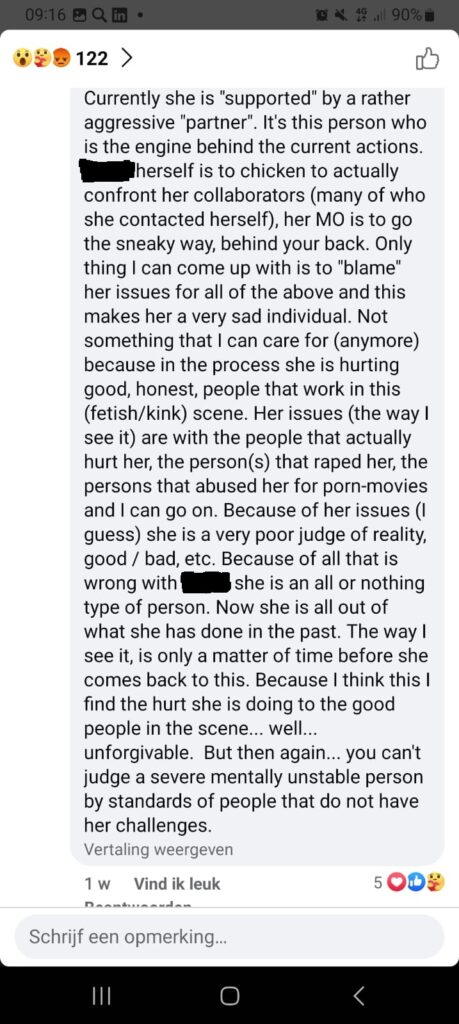The Fetlife community has been rocked by a series of gruesome murders in recent years. These crimes, committed by individuals who used the platform to connect with their victims, have left law enforcement officials and members of the community struggling to understand the motives and methods behind the violence.
The Fetlife Murders remain shrouded in a dark mystery, leaving many to speculate on the potential dangers of online communities and the psychological factors that contribute to violent behavior. In this in-depth analysis, we aim to provide insight into the Fetlife Murders, exploring the broader societal and cultural implications of this tragedy. Through examining the cases and patterns, psychological profiles of the perpetrators, and the impact of media sensationalism, we hope to shed light on the complex nature of these crimes.
Our analysis delves into the virtual realm of Fetlife, examining its influence on users and potential implications for the murders. We explore the darker aspects of the platform, including the potential risks and dangers associated with engaging in online communities like Fetlife. Additionally, we’ll discuss the blurred line between fantasy and reality in the Fetlife community and how it may have contributed to the murders.
By evaluating law enforcement’s response to these crimes, as well as the legal ramifications and victims’ support networks, we hope to provide a comprehensive understanding of the Fetlife Murders’ full impact. Lastly, we’ll offer practical advice on safety measures and precautions that individuals can take when engaging in online communities like Fetlife, and speculate on the community’s future changes and adaptations.
This article serves as a cautionary tale, highlighting the importance of ongoing discussions and awareness surrounding the risks associated with online communities. Through this analysis, we hope to provide insight into the Fetlife Murders and contribute to a larger conversation surrounding online safety and personal responsibility.
Understanding the Fetlife Community
Fetlife is an online social networking platform that caters to individuals into BDSM, kink, and fetishism. It was founded in 2008 and has since grown to include millions of members worldwide, making it one of the largest BDSM communities online.
The Fetlife community is formed around the idea of providing a safe space for individuals to explore their sexual interests and connect with like-minded individuals. The platform allows users to create profiles, join groups, attend events, and engage in discussions.
It is important to note that while Fetlife is associated with BDSM and kink communities, it is not a dating platform. [It is used as a hook up platform and pornographic website]. Instead, it is designed to facilitate conversation, education, and exploration of BDSM interests.
Exploring the Virtual Realm: Fetlife’s Influence
While Fetlife’s primary function is to facilitate communication and connection between like-minded individuals interested in alternative lifestyles, it has created a virtual realm that extends beyond its online platform. Users have reported that their involvement in the community has impacted their day-to-day lives, influencing their social interactions and shaping their personal identities.
As a result, Fetlife’s influence extends beyond the boundaries of the site and into the lives of its users, with the creation of subcultures that embrace alternative lifestyles and practices.
However, this influence is not without its potential dangers. The anonymity of online interactions can lead to a false sense of security and trust, potentially leading individuals to engage in risky behavior or trust others without adequate vetting.
Additionally, the nature of Fetlife’s community and the emphasis on fantasy and role-playing can lead to psychological impacts, blurring the line between fantasy and reality. This can result in individuals becoming desensitized to dangerous behavior and potentially contributing to the perpetuation of risky activities.
It is important to acknowledge the potential influence of Fetlife on its users and to approach interactions on the platform with caution and awareness of the risks involved. By staying informed and mindful of the impact of virtual interactions, users can mitigate potential dangers and maintain a safe and fulfilling experience within the Fetlife community.
Unveiling the Dark Side: Risks and Dangers of Fetlife
While the Fetlife community can provide a safe space for individuals with unique sexual preferences, it also has a darker side that cannot be ignored. The platform’s open nature and lack of regulation make it a breeding ground for potential risks and dangers.
One of the major risks associated with Fetlife is the possibility of encountering individuals with malicious intent. Predators can easily create fake profiles and prey on unsuspecting users. Additionally, the platform’s anonymity can make it difficult to verify the legitimacy of users and their intentions, leaving users vulnerable to exploitation or abuse.
Another danger of Fetlife is the potential for users to engage in risky or illegal activities. The platform’s focus on alternative sexual practices can attract individuals with extreme or non-consensual fetishes, leading to harmful encounters. Furthermore, the lack of regulation on the platform means that illegal activities such as prostitution or human trafficking can go unnoticed.
Finally, the unmonitored nature of Fetlife can be detrimental to individuals struggling with mental health issues. The platform’s open discussion of controversial topics can exacerbate conditions such as depression or anxiety, leading individuals down a dangerous path.
It is important for users to be aware of the risks and dangers associated with the Fetlife community and take the necessary precautions to protect themselves. This includes verifying the legitimacy of users and their intentions, avoiding engaging in risky or illegal activities, and seeking help if struggling with mental health issues.
The Murders Unveiled: Cases and Patterns
The Fetlife murders are a tragic example of the potential dangers of online communities. Over the years, several cases have emerged involving individuals who met through the platform, with fatal consequences.
One such example is the case of Brady Oestrike, who engaged in a consensual BDSM relationship with a couple he met on Fetlife. However, his behaviour soon became erratic and violent, leading to the murder of the couple and the suicide of Oestrike.
Another case involves the murder of Texas woman Jacqueline Vandagriff by Charles Dean Bryant, whom she had connected with on Fetlife just days before her death. It was discovered that Bryant had a history of violence and stalking.
These are just a couple of the many cases that highlight the risks of engaging in online communities like Fetlife. Certain patterns have emerged, including individuals with violent or criminal histories and those who engage in fringe sexual practices.
The complexity of these cases shows the need for greater awareness and education regarding the dangers of engaging in such communities, and the importance of taking precautions and being vigilant.
Examining the Role of Online Interactions
As with any online community, interactions on Fetlife can have a significant impact on users and their offline lives. In the context of the Fetlife murders, it is important to examine the role of online interactions in relation to the crimes.
While it is impossible to definitively determine the influence of Fetlife on the perpetrators’ actions, there is evidence to suggest that the platform may have played a role. For example, messages exchanged between the murderers and their victims on Fetlife have been cited as potential evidence in court.
Furthermore, the anonymity and platform’s focus on kinks and fetishes may lead users to engage in riskier behavior or disregard personal safety. The lack of face-to-face communication and physical boundaries may also contribute to a blurred line between fantasy and reality, potentially desensitizing users to dangerous situations.
It is important for users of Fetlife and similar communities to be aware of the potential risks associated with online interactions. Engaging in conversations and activities that prioritize consent and safety, as well as being cautious about sharing personal information, can help mitigate these risks.
Ultimately, while online interactions cannot be solely blamed for the Fetlife murders, they serve as a reminder of the potential dangers of engaging in virtual communities without proper precautions.
The Line Between Fantasy and Reality
The Fetlife community is known for exploring taboo sexual desires and fetishes in a safe and consensual manner. However, the line between fantasy and reality can become blurred, leading to dangerous situations.
Many users of Fetlife engage in role-play and fantasy scenarios that involve power dynamics, BDSM, and other potentially risky behaviors. While these activities can be harmless when conducted with consenting partners, they can also create a false sense of security and lead to dangerous situations outside of the virtual world.
The Fetlife murders highlight the potential dangers of blurring the line between fantasy and reality. Some of the victims were involved in BDSM and other fetishes with their attackers, but the situations ultimately turned violent and deadly. This serves as a stark reminder that even when engaging in consensual activities, it is important to maintain a clear understanding of reality and potential risks.
Furthermore, individuals who struggle with distinguishing fantasy from reality may be particularly vulnerable in online communities like Fetlife. It is important to recognize the difference between harmless fantasy and potentially harmful behavior, and seek help if necessary.
Investigating Law Enforcement’s Response
Law enforcement’s response to the Fetlife murders has been a topic of debate and scrutiny. While some applaud the efforts of law enforcement in solving the cases, others criticize the lack of attention given to the potential dangers of online communities like Fetlife.
The murders highlighted the need for law enforcement to better understand and monitor these virtual communities, as they may provide a platform for dangerous individuals to connect and communicate with potential victims. There have been questions about whether police departments are equipped with the necessary tools and training to effectively investigate crimes that occur within these online spaces.
Furthermore, the murders have raised concerns about the accountability of law enforcement in addressing crimes that occur within online communities. Given that many of these communities operate on a global scale, it can be difficult for law enforcement to track down and prosecute perpetrators, particularly when they are located in jurisdictions that have differing legal systems and enforcement mechanisms.
Despite these challenges, law enforcement has made progress in solving the Fetlife murders. Through extensive investigations and collaborations with other agencies, several individuals who committed these crimes have been brought to justice. However, there is still much work to be done to ensure the safety of individuals who participate in online communities like Fetlife.
Investigating Law Enforcement’s Response:

Learning from Tragedy: Safety Measures and Precautions
The Fetlife murders have shed light on the potential risks and dangers of online communities. While it is important to recognize the benefits and freedoms that the virtual world offers, it is equally important to take precautions and steps to ensure one’s safety. Here are some practical safety measures and precautions to consider when engaging with online communities like Fetlife:
- Exercise Caution: Be cautious when communicating with others online and always be mindful of personal information that you share. Trust needs to be earned, and it is crucial to be careful and wary of those who may have malicious intent.
- Safeguard Your Identity: Protect your identity by keeping your personal information private. Avoid using your full name, address, or phone number when creating your online profile. Using a pseudonym can help preserve your anonymity.
- Meet in Public: If you decide to meet someone you’ve met online in person, always meet in a public place. Inform someone you trust where you are going and who you are meeting. Consider taking someone with you.
- Trust Your Instincts: If someone or something makes you feel uneasy, trust your instincts. Always prioritize your safety and well-being over any social or emotional pressures.
- Continuously Evaluate: Continuously evaluate your interactions and relationships with others online. Be aware of warning signs of abusive or manipulative behavior and take steps to protect yourself if necessary.
It is crucial to take these safety precautions seriously and prioritize one’s safety when engaging in online communities. By being cautious and vigilant, individuals can enjoy the benefits of these virtual communities without putting themselves at risk.
Support Networks: Victim Advocacy and Resources
Victims of the Fetlife murders, and their families, require extensive support networks to cope with the aftermath of such heinous crimes. These networks must provide practical assistance, emotional support, and advocacy services to help victims navigate the complex legal and psychological aftermath.
Fortunately, victims have access to several resources that can support them during this difficult time. One such resource is the National Center for Victims of Crime, which offers a wide range of support services, including counseling, financial assistance, and legal advocacy. Similarly, the Sexual Assault Legal Institute provides free legal services to victims of sexual assault, including access to restraining orders and advocacy in court.
Other resources include local rape crisis centers, which often offer counseling, support groups, and assistance with medical and legal procedures. Many victims also benefit from the support of family, friends, and faith-based communities.
However, it is crucial to acknowledge that these resources may not always be accessible to all victims. Barriers such as financial constraints, geographic location, and social stigma can prevent some victims from seeking the support they need. It is therefore essential for communities to work together to create more inclusive and accessible support networks for all victims of sexual violence and online crimes.
Finally, it is important to recognize that advocacy and support for victims should not end with the resolution of a particular case. This support should be ongoing, recognizing the long-term impact of these crimes on victims and their families.
Legal Ramifications: Prosecution and Justice
The legal implications of the Fetlife murders are significant and far-reaching. Law enforcement agencies across the globe have been tasked with investigating and prosecuting the individuals responsible for these heinous crimes. The successful prosecution of these cases has led to the award of justice for the victims and their families, as well as serving as a deterrent for potential future perpetrators.
The prosecution process begins with the collection and analysis of evidence, followed by the formal charging of the accused. This may be followed by a trial, where evidence is presented to a judge and/or jury, and a verdict is reached. The sentencing phase then follows, where the severity of the punishment is determined, often taking into account aggravating and mitigating factors.
Despite the successful prosecution of some Fetlife murder cases, there have been instances of perpetrators being acquitted or receiving less severe sentences than expected. This has led to criticism of the legal system and calls for reform. Victim advocacy organizations have also raised concerns about the need for greater support for victims and their families during the prosecution process.
Ultimately, the pursuit of justice for the victims of the Fetlife murders is an ongoing process. As such, it is important for law enforcement agencies and legal systems to continue to adapt and evolve in response to the changing nature of online communities and related criminal activity.
Societal Impact: Discussions and Debates
The Fetlife murders have sparked widespread discussions and debates surrounding the safety of online communities, personal responsibility, and ethical considerations. Many have questioned the role of online platforms like Fetlife in facilitating dangerous behavior, leading to calls for increased regulation and oversight. Others argue that individuals must take personal responsibility for their actions online, recognizing the potential risks and making informed choices.
One important point of debate has been the blurred line between fantasy and reality in the context of the Fetlife community. While many users engage in BDSM and other taboo activities purely for pleasure, others may harbor dangerous intentions that can lead to harm for themselves and others. The question of how to distinguish between harmless fantasy and genuine danger remains a subject of ongoing discussion and debate.
At the same time, the Fetlife murders have brought attention to the importance of victim advocacy and support networks. Resources and organizations have emerged to provide support to survivors and victims’ families, highlighting the need for greater access to emotional and legal support for those affected by online crimes.
Ultimately, the societal impact of the Fetlife murders extends far beyond the specific cases themselves, sparking vital discussions and debates about our collective responsibility to ensure safety and ethical behavior in online communities.
Future of Fetlife: Changes and Adaptations
With the tragic events surrounding the Fetlife murders, it is unlikely that this community will remain untouched. Significant changes and adaptations may be necessary to ensure the safety and security of its members.
One possible change that Fetlife may undergo is the implementation of more stringent safety protocols. This could include mandatory verification of user identities, more thorough background checks, and enhanced monitoring of user activity. Additionally, Fetlife may need to increase its moderation efforts to prevent harmful content and behavior from being promoted or shared within the community.
Another potential adaptation could be the development of new technologies or features that prioritize safety. Fetlife may need to look to other online communities or social networks for inspiration and guidance on how to best protect its members.
However, any changes or adaptations must be made with care and consideration to avoid alienating existing members or compromising the purpose and values of the community. It will be crucial for Fetlife to continue to listen to feedback from its members and make informed decisions that prioritize safety and wellbeing.
Conclusion
The Fetlife murders represent a dark mystery with numerous implications for online communities. Through our analysis, we have gained insight into the risks and dangers of platforms like Fetlife, as well as the potential impact of media sensationalism.
It is crucial that individuals engaging in online communities understand the blurred line between fantasy and reality, take precautions to protect themselves, and seek support when needed. Furthermore, law enforcement must continue to develop effective strategies for preventing and solving crimes in the virtual realm.
As for Fetlife, the community may undergo changes and adaptations in response to the tragedies that have occurred. However, it is vital that ongoing discussions and awareness surrounding the risks of online communities continue to take place.
Overall, the Fetlife murders serve as a reminder of the importance of online safety and personal responsibility. We must continue to evaluate the impact of virtual interactions on our society and prioritize the well-being of individuals engaging in them.
FAQ
Q: What is Fetlife?
A: Fetlife is an online community focused on BDSM, fetish, and kink. It provides a platform for like-minded individuals to connect, share experiences, and explore their interests.
Q: Are there any risks associated with using Fetlife?
A: Like any online platform, there are risks involved in using Fetlife. It is important to practice caution and take necessary precautions when engaging with others on the site.
Q: How can I ensure my safety on Fetlife?
A: To ensure your safety on Fetlife, it is advisable to thoroughly vet the individuals you interact with, maintain boundaries, and communicate openly about your expectations and limits.
Q: What should I do if I encounter suspicious or inappropriate behavior on Fetlife?
A: If you encounter suspicious or inappropriate behavior on Fetlife, it is recommended to report the user to the platform administrators and, if necessary, involve law enforcement.
Q: Are the fetlife murders isolated incidents?
A: The Fetlife murders are specific cases that have occurred within the context of the Fetlife community. While they are not representative of the entire community, they highlight the importance of online safety.
Q: How can I support victims of the Fetlife murders?
A: Supporting victims of the Fetlife murders can be done by raising awareness, advocating for resources and support networks, and encouraging open and honest discussions about online safety.
Q: What is the role of law enforcement in addressing the Fetlife murders?
A: Law enforcement plays a crucial role in addressing and investigating the Fetlife murders. It is important to evaluate their response and effectiveness in solving and preventing future crimes.
Q: Can media sensationalism have an impact on the understanding of the Fetlife murders?
A: Media sensationalism can have a significant impact on the public’s understanding of the Fetlife murders. It is important to critically analyze media coverage and consider its potential consequences.
Q: How can individuals ensure their personal safety when engaging in online communities like Fetlife?
A: Individuals can ensure their personal safety when engaging in online communities like Fetlife by implementing safety measures such as using pseudonyms, being cautious about sharing personal information, and setting boundaries.
Q: What are some available support networks for victims of the Fetlife murders?
A: There are various support networks and organizations available for victims of the Fetlife murders. These resources provide advocacy, counseling, and assistance to those in need.
Q: What legal ramifications are associated with the Fetlife murders?
A: The legal ramifications of the Fetlife murders involve the prosecution of the perpetrators and the pursuit of justice for the victims. The legal process plays a crucial role in holding individuals accountable for their actions.
Source: https://techcritix.com/guides/unraveling-the-dark-mystery-behind-fetlife-murders-an-insight/
Een reactie plaatsen






